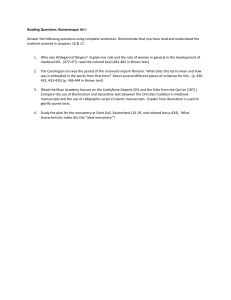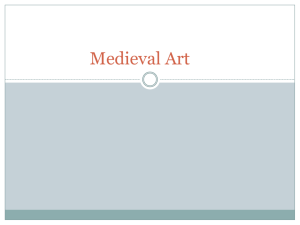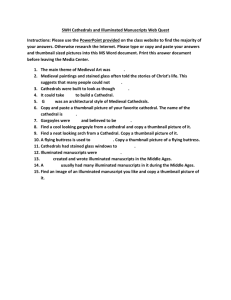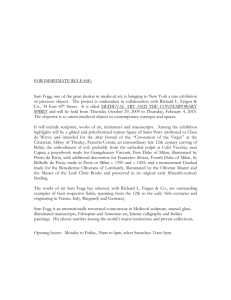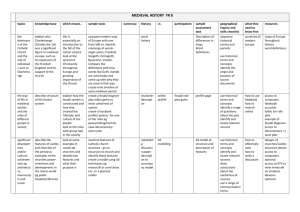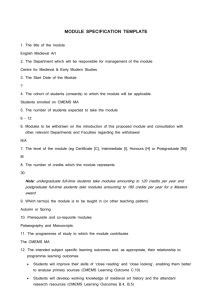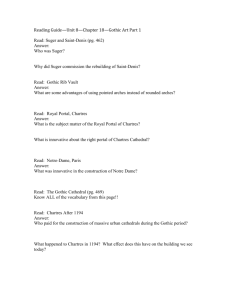Early Medieval Art - Gage Park Academy
advertisement
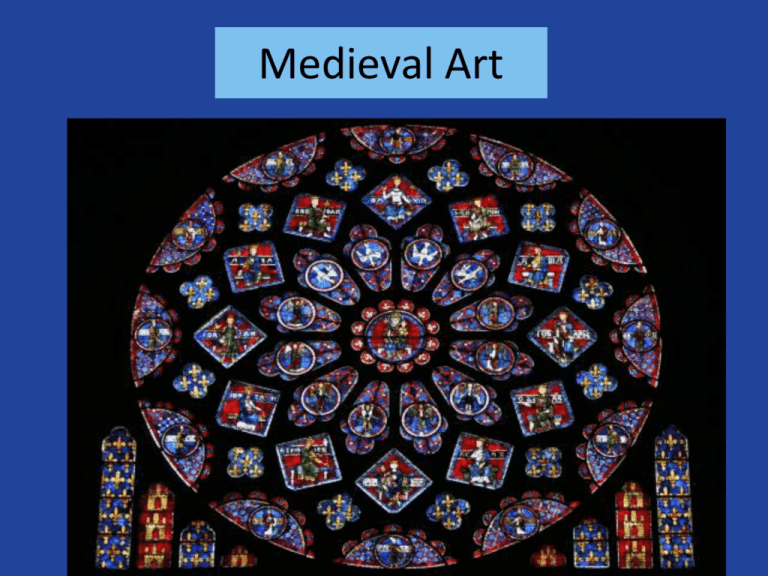
Medieval Art Medieval Art The medieval period of art history spans from the fall of the Roman Empire in 300 AD to the beginning of the Renaissance in 1400 AD. During the Middle Ages art and architecture in Europe was devoted almost exclusively to serving the Christian church. Medieval Art Illuminated Manuscripts Before the invention of mechanical printing, books were handmade objects, treasured as works of art and as symbols of enduring knowledge. Indeed, in the Middle Ages, the book becomes an attribute of God. What is an illuminated manuscript? Medieval Art Illuminated Manuscripts What is an illuminated manuscript? Illuminated manuscripts are books written by hand and painted with precious pigments. Manuscripts contain most of the finest surviving examples of medieval painting. Where does the word manuscript come from? The word manuscript is derived from the Latin words manus (hand) and scriptus (to write). What does the word illumination mean? The word illumination comes from the Latin verb illuminare (to light up) and is defined as the decoration of a manuscript with bright shimmering colors (especially gold). The artist who produced the lavish artwork on illuminated manuscripts were called Illuminators. Medieval Art Illuminated Manuscripts Who created the illuminated manuscripts? Medieval Monks painstakingly created illuminated manuscripts; copying religious texts and embellishing them. In Christianity, a monk is a man dedicated to a religious life in a monastery, living according to a particular rule and under vows of poverty, chastity, and obedience. What were the illuminated manuscripts made of? Illuminated Manuscripts were generally written in ink on parchment or vellum. Parchment was made of animal skins. The text was first written by a scribe and then the gold leaf was applied by the illuminator. The application of color was then added following a planned design. What did the medieval manuscripts look like on the outside? Metal clasps or ties of leather or fabric were used to keep the manuscript closed. Bindings were sometimes embellished with paint or with designs stamped with metal tools; the most precious manuscripts were adorned with metalwork and jewels. Medieval Art Illuminated Manuscripts Two Men before a King and A Man Speaking to a Family, Unknown Illuminator, from the Vidal Mayor, Spanish, about 1290–1310 Medieval Art Illuminated Manuscripts Illuminated Manuscripts Medieval Art Illuminated Manuscripts This illustrated scene corresponds to a portion of the text devoted to the legal rights of orphans. In the top half of the image, a man in a red robe speaks with the king about the sale of a piece of property. He appears again to the far right, having received the king's judgment. Below, he is shown a third time, approaching a couple and a small child. Because the man's petition to sell the property would deprive the child of his rights to the estate, it is denied. http://www.getty.edu/art/exhibitions/ glory/gothic_interactive.html Medieval Art Illuminated Manuscripts The two scenes take place in the upper and lower halves of an initial A . The letter is formed by the arching body of a dragon; the beast's folded wings are seen on the left while its small doglike head is at the lower right. The two human-headed birds perched on top of the square frame add liveliness to the page. Medieval Art Illuminated Manuscripts Lindisfarne Gospel Book What letters are illuminated here? Can your eye follow the looping and curving lines of this intricate design? What is hidden inside of the letters? Medieval Art Illuminated Manuscripts Lindisfarne Gospel Book This page from the Lindisfarne Gospel Book shows the beginning of the Gospel of St. Matthew. The X-P is a contraction of the Greek name for Christ. The illustration is beautifully interlaced with abstract and geometric designs of minute detail. Hidden in the curves and swirls are serpents, dragons and other fantastic animals. Medieval Art St. Matthew the Evangelist, from the Gospel Book of Archbishop Ebbo of Reims, 816-835 Describe the artwork. What is being depicted here? St. Matthew the Evangelist, from the Gospel Book of Archbishop Ebbo of Reims, 816-835 Compare and Contrast St. Matthew the Evangelist, from the Gospel Book, Rhineland, about 800 The first St. Matthew is extremely expressive and is filled with energy as he hurries to write his Gospel. He appears to be seized with divine inspiration. The second St. Matthew is Classical and calm; the saint is intent on setting down his own thoughts. The contrast between these two styles shows the wide range in style that existed in the ninth century. Medieval Art Gothic Architecture Cathedrals became the religious, cultural and social centers of the growing cities during the 12th and 13th centuries. Unity is the key word in Gothic architecture. Interiors and exteriors belong together and are similarly decorated. Chartres Cathedral, France, 1194 Gothic Architecture Best remaining example of Gothic architecture Cathedral incorporated new ideas First cathedral to use flying buttresses Used groin vaults Overall feeling of verticality-super high interior reaches toward heaven Lots of light comes in through beautiful stained glass windows. Chartres Cathedral, France, 1194 Gothic Architecture A flying buttress is a free-standing arch--usually made of brick or stone--built against a wall to support or reinforce it. Architects in northern France wanted to build big impressive Gothic cathedrals, and they wanted their cathedrals to be full of light. But if the walls were mostly glass windows, how would they hold up the heavy stone roof? Instead of the buttress being stuck to the side of the building, it would form an arch leading away from the building. The flying buttresses would carry the weight of the roof away from the building and down a column of stone to the ground. With flying buttresses more of the church walls could be made out of glass, and the cathedral looked lighter and more heavenly. Chartres Cathedral, France, 1194 Gothic Architecture The simplest kind of vault is the barrel vault which is generally semicircular in shape. The barrel vault is a continuous arch. A groin vault is produced by the intersection at right angles of two barrel vaults. Sometimes the arches of groin vaults are pointed instead of round. Chartres Cathedral, France, 1194 Gothic Architecture A groin vault is produced by the intersection at right angles of two barrel vaults. Chartres Cathedral, France, 1194 Gothic Architecture Chartres Cathedral, France, 1194 Gothic Architecture Chartres Cathedral, France, 1194 Gothic Architecture Chartres Cathedral, France, 1194 Gothic Architecture Medieval Art Stained Glass Stained glass reached its peak in the magnificent windows of Gothic structures like Chartres Cathedral The colors glow when light passes through the glass First the stained glass artist put a full scale line drawing on a board Then sheets of glass were cut according to the lines Paint was then applied to create shading and details Then pieces put together like a big puzzle using lead strips Reds and blues dominated Gothic stained glass, looks like glowing huge jewels Stained glass served as brilliant colored visual teaching aids for the church Medieval Art Stained Glass The stained glass windows of Chartres Cathedral are some of the most extensive and beautiful medieval windows to survive anywhere. There are about 170 Chartres windows in total covering 21,000 square feet. Their subjects including biblical stories, legends of the saints, the lives of heroes like Roland and Charlemagne, and scenes of everyday medieval life. Rose Window is a circular window that is characteristic of Gothic church architecture Medieval Art Late Gothic Painting Giotto, The Lamentation, 1305, Fresco Giotto revolutionized painting by reviving the art of working from nature His paintings may not seem revolutionary today, but at that time few artists were interested in painting from nature because emphasis was placed on the symbolic Giotto was before his time-led us into the Renaissance Giotto’s masterpiece is a series of frescos that decorate the walls of Arena Chapel The frescos illustrate the lives of Christ and the Virgin Mary The Lamentation is one painting in the series Medieval Art Late Gothic Painting Giotto, The Lamentation, 1305, Fresco Giotto, The Lamentation, 1305, Fresco The scene looks like it is played out by real people The figures are in active, nature poses The shading creates a sense of roundness and mass Natural light comes from above, Natural landscape/sky (not gold background)-more realistic Emotion of sorrow expressed on every face Medieval Art Gothic Painting Giotto, The Lamentation, 1305, Fresco Compare and Contrast Giotto, The Lamentation, 1305, fresco Barna Da Siena, The Crucifixion and the Lamentation, fresco

